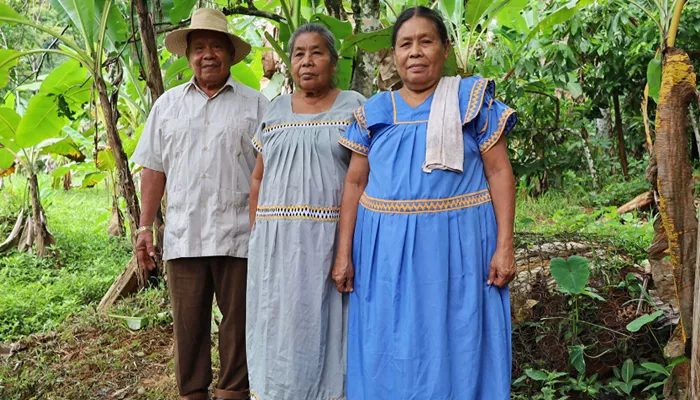In 2021, amidst the COVID-19 pandemic, Mauricio Martínez faced the grim reality of his deteriorating health. Gravely ill and struggling to breathe, he made a poignant decision to leave behind the hospitals of Panama City in favor of his home in the Ngäbe-Buglé Indigenous village of Santa Marta. There, he hoped to spend his final moments surrounded by family and the natural remedies that have been a lifeline for his community.
“I spent all the money I had left to get a private car to drive me nine hours from Panama City so that my family could see me alive one last time,” recalls Martínez, now a 44-year-old man with a tall frame and a thin beard. His father, a local shaman, welcomed him back and offered him traditional medicinal plants through teas and liquid drops. Miraculously, over the course of a few days, Martínez began to recover.
“Thanks to traditional medicine, I survived,” he asserts. “I know I wouldn’t be here without it.”
A Rich Tradition at Risk
Santa Marta, a small town of approximately 500 residents near Panama’s Caribbean coast, is steeped in the traditions of medicinal plant use. Local shamans have cultivated their knowledge for generations, drawing on the lush biodiversity of the surrounding jungles. However, the sustainability of this rich tradition is under threat. Young people are leaving the comarca, seeking employment opportunities in urban centers like Panama City, which diminishes the transmission of this vital knowledge to future generations.
“We don’t want to leave the next generation with zero understanding of how to use these plants,” says Martínez’s father, Mauricio Sr., a 73-year-old shaman who mixes his native Ngäbere language with Spanish. “There has to be someone pushing it forward.”
Iho Kebery: A Beacon of Hope
In response to the encroaching threat of losing their ancestral practices, the shamans of Santa Marta took proactive measures in the early 2000s. They collaborated with Panama’s National Environment Authority (ANAM) to establish a health clinic named Iho Kebery in 2009, named after a legendary Ngäbe-Buglé warrior. The clinic is painted in earthy tones and adorned with images depicting traditional healing practices.
Despite its significance as the town’s only health facility, Iho Kebery lacks basic utilities like electricity and running water, which hampers its ability to function as a comprehensive health resource. “We need a space large enough to allow the midwives to work, prepare the medicine, and deliver a child safely,” insists Mauricio Sr. The lack of proper facilities is a barrier to the shamans’ mission of preserving and sharing their medicinal knowledge.
Community Collaboration for Preservation
To further secure the future of their traditional medicine, shamans and local residents, along with ANAM, published a 19-page booklet detailing local medicinal plants, their uses, and their identification. “We inherited this knowledge from our ancestors, and it’s part of the mystery of our people,” emphasizes Viviana Montero, a 72-year-old shaman and one of the booklet’s authors.
Ethnobotanical Studies: Documenting Knowledge
Recognizing the urgency of preserving their practices, local activist Eligio Castillo initiated contact with researchers from the Technological University of Panama. In 2021, these scientists visited Santa Marta to study the plants used by the shamans. Led by biologist José Ulises Jiménez, the team documented the medicinal properties of 17 plant species essential to the community’s health practices.
Their research revealed that these plants are used to treat various ailments, from diarrhea to snakebites. “Medicinal plants have a promising future,” the researchers noted, underscoring the importance of preserving such knowledge in light of the vast potential still untapped in nature.
A Community’s Faith in Traditional Remedies
As the sun rose on a humid August morning, residents gathered at Iho Kebery to share testimonials about their reliance on traditional medicine. Many spoke of how they survived various health crises thanks to the healing properties of local plants.
Martínez, who continues to experience lingering effects from COVID-19, expressed his gratitude for his decision to return to Santa Marta. “Here, lives are saved with traditional medicines,” he reflects. “Thanks to God, and specifically thanks to traditional medicine, I’m one of them.”
Conclusion: The Path Forward
The story of Santa Marta is a testament to the resilience of traditional knowledge in the face of modern challenges. While the community grapples with the realities of a changing world, the commitment of its shamans and residents to preserve their medicinal practices offers a glimmer of hope. Their journey serves as a reminder that traditional medicine, rooted in nature and history, holds the potential to heal, not only individuals but the very fabric of their cultural identity.
Related topics:
- Abundance London Plants Thousands of Bulbs to Illuminate Chiswick
- How Plants Compete for Light: New Mechanism Found in Shade Avoidance
- Woman Uses Distilled Water on Plant, Amazed by Its ‘Dramatic’ Change


